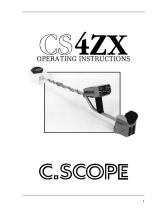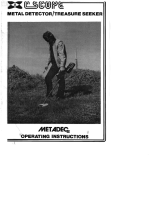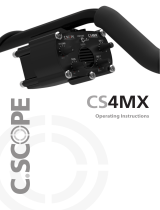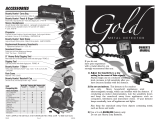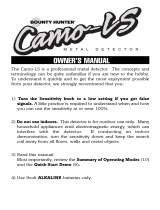Page is loading ...

RAPID GET YOU GOING INSTRUCTIONS
1. Assemble and adjust for length (Twist surplus lead around stem).
2. Insert batteries.
3. Set DISC 1 (top right) to ALL METAL (fully anticlockwise).
4. Set DISC 2 (bottom far right) to 5.
5. Set SENSITIVITY (top left) to 3 o'clock position.
6. On CS5MX only:-
Push BATT CHECK down and hold to indicate battery condition. Good batteries
will be in the green area on the meter. Release.
7. On CS5MX only:-
Set BOOST to NORMAL.
You are now in ALL METAL MOTION MODE.
You will find all metals within the search head range including iron and trash
PROVIDING THE SEARCH HEAD IS MOVING OVER THE TARGET
(not stationary).
To ignore low value metals (iron & trash)
:-
8. Adjust DISC 1 (top right) to position 5.
You are now in DISCRIMINATING MOTION MODE.
The other modes require more detailed explanation acquired from reading the full
instructions.
IF A PROBLEM IS ENCOUNTERED REFER TO THE FULL INSTRUCTIONS.
1

CONTENTS:
PAGE
INTRODUCTION 4
ASSEMBLY 4
BATTERIES 4
BATTERY CHECK 5
CONTROLS AND WHAT THEY DO 6
OPERATING YOUR METAL DETECTOR 10
DETECTION RANGE 10
DETERMINING THE TARGET SIZE AND DEPTH 10
ACCESSORIES (OPTIONAL) 11
CHARGING BATTERIES 11
THE IMPORTANCE OF THE RIGHT APPROACH 11
SWEEPING TECHNIQUE 13
CODE OF CONDUCT FOR METAL DETECTOR USERS 14
CARE OF YOUR DETECTOR 14
DETECTOR NOT OPERATING? 15
2

Controls
89
CS2MX
10
11 12
CS2MX
CS5MX
8139
14
10
15 11 12
CS5MX
1 Battery Compartment
1
2
3
4
5
6
7
2 Upper Stem & Handle Grips
3 Din Plug & Socket
4 Stem Connecting Nut
5 Cable
6 Lower Stem
7 Search Head Fastener
8 Power On / Off & Sensitivity
9 All Metal Mode / Discrimination 1
10 Pinpoint
11 Disc 2 Select
12 Discrimination 2
13 Signal Meter (CS5MX only)
14 Boost Hi / Normal (CS5MX only)
15 Battery Check (CS5MX only)
3

INTRODUCTION
To protect your investment complete both sections of the enclosed guarantee card and return the
reply paid portion to C-Scope. This is particularly important in order to register for the free
extended parts guarantee (UK only). Please retain the original packing box. In the event that
your detector should ever require to be serviced, this package will be most suitable for postal
protection.
C-Scope detectors are recognised as the finest detectors available. They are designed with lasting
quality, high technology, and above all, value for money. The only way to realise this value is to
carefully study and understand this instruction manual. You will then be able to obtain all the
advantages designed into your detector. It is also strongly recommended that you experiment with
the detector's operation in air using various test samples, in order to learn to identify and
understand the detector's capabilities and responses. Always remember that becoming a good
metal detectorist is like becoming a good photographer or fisherman, that is, although it is an
advantage to buy the best equipment, having bought it, patience and hours of practice are needed
to become proficient.
ASSEMBLY
Open the carton and remove the main housing assembly. Twist the plastic stem lock, located at
the end of the upper stem to allow the lower stem to be inserted. Adjust for length and rotate the
lower stem to wrap the cable around the stems and take up any slack. Allowing enough cable for
free movement of the search head push the cable into the cable slots to hold it firm. Turn the stem
lock to fix it at the desired position.
BATTERIES
Your detector is powered by eight AA batteries (not supplied) available from garages, department
stores, etc. or a single 12v rechargeable pack from C-Scope. It is advisable to use standard
batteries to start with. You can then evaluate the sort of use you give the detector and decide
whether the investment in rechargeables is justified.
HEADPHONE
SOCKET
BATTERY
COMPARTMENT
CHARGER
SOCKET
Battery
Compartment
4

The batteries should be fitted in the holder which is located in the battery compartment. To fit
new batteries first check the power switch on the unit is switched to OFF. Then loosen the two
captive screws located in the battery cover (do not fully remove these from the cover) and remove
the cover. Inside is the battery holder. Lift out the holder and detach the connector if it is already
fitted. Load it with the eight batteries ensuring that each battery is inserted the correct way round,
(direction of batteries alternating). Roll each individual battery to ensure it is located correctly
and making proper contact. Replace the connector making sure that it is firm and well seated, and
put the loaded holder into the housing. Fit the cover and tighten the two captive screws finger
tight.
Note: Zinc Carbon batteries should not be left in the detector for long periods where they could
leak, so remember to remove them at the end of a day's searching.
BATTERY CHECK
CS2MX only
The battery condition is indicated by an
audio tone.
A loud, clear and sharp signal indicates the
batteries are of good strength.
A weak, broken or non-existent signal
means you should replace the batteries.
CS2MX
CS5MX only
A battery condition indicator is provided
on the detector. To do this for the first time
prior to reading the remainder of the
operating instructions proceed as follows:-
Turn the SENSITIVITY (POWER) control
on. Press the centre push switch marked
BATT CHECK and hold down. The meter
will indicate in the green area if the
batteries are good and in the left or central
position if the batteries need replacing or
recharging. Release the switch and turn the
SENSITIVITY control off. Rechargeable
batteries will not read as high into the
green as standard batteries even when fully
charged. They also give less indication of
discharge on the meter during use.
CS5MX
Hold
Push Switch
5

CONTROLS AND WHAT THEY DO
7
1
2
65 48 3
1. On/Off - Sensitivity 5. Pinpoint push select button
2. Disc 1
6. Boost (CS5MX only)
3. Disc 2 7. Signal Meter (CS5MX only)
4. Disc 2 push select button 8. Battery Check (CS5MX only)
1. ON/OFF - SENSITIVITY
Switches detector on by rotating clockwise and adjusts sensitivity to metal.
This is a silent operating detector and you should rotate the Sensitivity Control
clockwise to the position where the audio threshold tone is comfortable.
Operate the Sensitivity at the highest level possible but, if you experience
interference from external radio transmissions or soil mineralisation, reduce the
level to eliminate this.
2. DISC 1
In the clicked off position, the detector indicates all metal objects.
Turned clockwise it becomes a fully variable discrimination control.
Discrimination is a means of ignoring objects which are generally regarded as junk
whilst still detecting the good objects.
At the lowest setting most iron objects are ignored. Increase the setting and the
detector will ignore even larger pieces of aluminium paper as well as iron.
At higher levels still, ring pulls will be ignored. You must, however, realise that at
this higher setting you will also lose some low denomination and silver hammered
coins, so set the control only as high as necessary to ignore iron and foil
contamination (e.g. level 5 is typical).
6

Effect of Discriminate Control Position
SCREW CAP
RING PULL
NAIL
HORSESHOE
5p COIN
CIGARETTE
PACKET
MILK
BOTTLE TOP
3. DISC 2
This control is identical to Disc 1 and allows you to further identify the target signal
being received.
With Disc 1 set at 5 to reject small iron and silver foil, commence searching.
Remember the detector is a motion detector, which means that the search head needs
to be constantly sweeping (except in pinpoint mode - see page 9).
You now need to set Disc 2 to ignore ring pulls.
Sweep the head above a ring pull and rotate Disc 2, at the same time depressing the
Disc 2 push select button with the thumb of the hand holding the metal detector.
When the ring pull signal disappears this control is set. Release the push button.
Your detector automatically operates in Disc 1 so commence searching (see
"Sweeping Technique" on page 13).
When you receive a signal, this indicates that the target could be a silver hammered
coin, 5p, ring pull, £1, 2p or gold etc.
Depress Disc 2 button and hold it. Sweep the target object again. If you are still
receiving a signal, then it is likely to be any of the metals found above ring pulls, e.g.
£1, 2p or gold etc.
Disc 2 gives you greater analytical skills than a single discrimination metal detector
but, even when Disc 2 does not give a signal, still dig up the target to avoid losing
silver hammered or 5p etc.
Three points to remember:
1. Large iron objects, particularly if near the surface, can produce a signal
regardless of discrimination settings.
2. Although Disc 1 and 2 are set to ignore metals at the same position there may
be slight variations in your detector and between different detectors.
3. Practice, in air, with various metal objects so you understand the detector
capabilities and responses.
7

The more familiar you become with your metal detector the more skilful
combinations of Disc 1 & 2 you will use. The following chart gives a few ideas of
setting and the conditions under which you would employ them.
DISC SETTING
REF DISC 1 DISC 2 WHEN USEDWHEN USED
A
0 0 All metal detecting.
B
5 0 Dig all signals.
C
5 7 To analyse possible ring pulls etc (see above).
D
5 10
If searching for modern currency (e.g. £1
coins) in a highly screw cap contaminated
site (e.g. picnic area).
E
7 0 Use on beach or picnic site which is highly
ring pull contaminated.
F
10 0 Use on same site as above except where
highly screw cap contaminated.
NOTES:
i) When using references E & F please be sure that the search site would
not yield silver hammered coins which may be ignored at these high
discrimination settings.
ii) In reference A, you may need to reduce sensitivity in highly mineralised
or beach sites.
iii) These settings are guidelines only and you should practice with various
known objects to ensure that you are familiar with the settings correct for
your machine.
4. DISC 2 PUSH SELECT BUTTON
See Disc 2 control above.
5. PINPOINT PUSH SELECT BUTTON
As stated on page 7, this is a motion detector which requires the head to be constantly
moving. When you have located a target you must pinpoint it carefully to avoid
unnecessary digging.
When held down, the pinpoint button enables the detector to give a varying response
which peaks directly above the target.
To pinpoint a target carry out the following procedure:
8

1. Move the search head to a known clear patch.
2. Hold the pinpoint button down and return the head to the target area; move it
slowly and listen for the peak response, or observe it on the meter.
The all metal pinpointing mode gives a positive response to all metals irrespective of
the Discrimination setting.
It is not necessary to sweep the target as the pinpoint mode will respond even when
held stationary over the object although the target will fade gradually if the head is
held over it for too long.
Normal and Pinpoint Response
NORMAL RESPONSE PINPOINT RESPONSE
SOUND LEVEL
6. SIGNAL METER/BATTERY CHECK (CS5MX only)
This is a visual indication of the signal strength giving the experienced user more
information about the target. This is particularly useful for pinpointing.
When the BATT CHECK is pressed, the meter will indicate condition of the batteries.
If the meter reading falls below the green band, the batteries should be replaced.
7. BOOST HI/NORMAL (CS5MX only)
For general detecting work, NORMAL mode should be selected.
When increased sensitivity to deep objects is required, then the setting HI should be
used. However, if false signalling occurs due to soil mineralisation, revert to the
NORMAL setting.
9

OPERATING YOUR METAL DETECTOR
Check the batteries are in good condition prior to searching. Frequently check the battery
condition during the search. Rechargeables give little warning of failure so ensure they are fully
charged prior to a long period of searching or carry a fresh set with you. ( See Batteries, page 4).
The unit may operate with reduced sensitivity for a period after indicating 'flat' batteries.
However the batteries should be replaced or recharged at the first opportunity.
Use headphones when possible. Not only do they extend battery life, but they also cut out
extraneous noise.
(It is instructive to bury some objects in a clear patch of soil and note the response when swept at
different rates with DISCRIMINATE at various levels). Large pieces of iron are difficult to
ignore and may give confusing signals. An aid to determine whether the target is iron or not is to
go into an all metal mode either by turning the DISCRIMINATE off or simply pressing the
PINPOINT button. Iron objects will generally give a stronger more positive signal than good
objects.
When operating on the beach the all metal mode may give a response to the beach itself. If this is
the case operate the unit with the DISCRIMINATE level set to the point at which it is ignored.
If in doubt as to whether the target is good or not we always recommend that you should dig it
up. Your knowledge of how the detector responds will increase each time and soon make you
more sure.
DETECTION RANGE
Detection ranges will vary depending on the size of the object, the length of time an object has
been buried, and the type of ground the object is buried in. The best ground conditions are well
compacted soils and coins can be found at the greatest depth if the object has been buried for
some time and the coin has interacted with the salts in the ground, thereby appearing larger to the
detector. The worst conditions for detecting are on loosely compacted or freshly dug ground or
when the object has only recently been buried. In these conditions detection range will be
reduced. 90% of all artefacts are found within 6" of the surface.
N.B. Your metal detector is a top performance deep seeker but adverse soil conditions can
significantly reduce the depth of detection.
DETERMINING THE TARGET SIZE AND DEPTH
An operator who is familiar with his instrument will be able to do an excellent job of determining
object size, shape and depth before he digs. This technique is learned from careful analysis of the
meter and audio signal coming from the detector. Each time a signal is heard, listen for any
peculiar characteristics it may have, determine over how large an area you get a detector signal,
and try to 'outline' the object before you dig. After digging up the object, compare the object size,
shape, depth and position in the ground with signal information you received before digging.
After careful analysis of many signals you will learn to 'read' the hidden target before digging.
10

ACCESSORIES (OPTIONAL)
Available from C-Scope.
Headphones:
Headphones not only extend battery life but improve sensitivity by cutting extraneous noise. The
headphones should be fitted with a standard stereo 1/4 inch (6.35mm) jack plug. The headphone
socket is located under the protective cap in the battery housing.
Rechargeable battery pack:
A shrink wrapped pack of 8 rechargeable nicad batteries to replace the standard batteries and
holder.
Battery charger:
The C-Scope battery charger is designed to charge the rechargeable pack quickly and safely.
CHARGING BATTERIES
A battery charge socket is provided for use with the C-Scope battery charger (see Accessories)
and is located under the protective cap in the battery housing. (The smaller of the two sockets.)
Inserting the charger will automatically remove the power from the detector so the charger must
be removed to do a battery check. Do not attempt to recharge standard batteries. It will take
between eight and fifteen hours to fully recharge flat batteries with the C-Scope charging unit.
For further information, and a price list, for all C-Scope accessories please telephone
(01233) 629181.
THE IMPORTANCE OF THE RIGHT APPROACH
Treasure hunting can be a profitable and rewarding hobby, if approached in a patient and diligent
manner. Time spent researching to locate a worthwhile site for a search can be time wasted if
your search is hasty and erratic. To achieve maximum results it is important then, to decide on
your approach to any particular site in advance of the actual search.
Tactics will be decided by the type of site - it is more profitable to scan a small area thoroughly
than to conduct a haphazard search of the total site. However, when the site is too far away for
you to make several return visits, a plan should be adopted which gives maximum coverage, at
the same time as indicating the most likely area for detailed search.
Your detector alone is not a guarantee of successful treasure hunting. Any detector needs an
operator and for the best results the operator needs the right approach, attitude and technique. Too
many beginners neglect the importance of pre-planning and research before using their detector
in the field, and patience and technique during the actual search.
11

A successful search should begin with research some time before the day of the actual search.
The extent and thoroughness of your research will be one of the major factors in the success of
your detecting. You should aim to get as complete an understanding as possible of the local
history and geography.
The key to the choice of site is to think of people, where they congregated over the past few
hundred years. What were their customs and pursuits? Where did they spend money? Where did
they carry money? The answers are not Roman sites, nor are they associated with mystic treasure
stories of crocks of gold. Rather, they are unassuming, undramatic places, like public footpaths
and ancient rights of way, old houses and so on.
When you have chosen your site, allocate a whole day from early morning to early evening for
the search. Make sure you have all the equipment you are likely to need. Your detector should be
checked before starting out, and you should always carry a spare set of batteries. You will also
need a strong, sharp trowel. It is also a good idea to have a set of lines and pins so that you can
lay out your search area scientifically.
Most beginners make the mistake of rushing about hoping to chance upon a rare find. If for
example there happened to be a valuable ring that was buried 4" deep on the site you were
searching, if you rushed about haphazardly and quickly on the site, the odds would be very much
against you finding it. On the other hand, if you pegged out the area scientifically and searched
slowly and thoroughly, the odds of finding the ring would be very much more in your favour.
Remember, BE PATIENT and WORK SLOWLY. Do not try to cover too large an area, restrict
yourself to a small area and work through it thoroughly. Make a note of the position and the
extent of the area, and then when you return you can start again further on without missing any
ground or covering the same area twice.
It is also important to keep the detector head as close to the ground as possible. Ideally, you
should 'iron' the ground with the search head of the detector, so that you do not lose any detection
range. Similarly, if you work slowly and carefully you should be able to distinguish the faint
signals as well as the clear-cut signals and further increase your finds.
The technique of getting the best out of your detector is not learnt overnight. You need to get as
much experience as possible so that you can recognise every kind of signal. Indeed, a good
detector operator can often tell you what is being detected before it is unearthed.
12

Search Head Position
AB
C
D
It is essential that the search head is kept close and parallel to the ground as in B. Do not hold the
search head too high above the ground, or at an odd angle as in A, C, D as you will be apt to miss
finds.
SWEEPING TECHNIQUE
For extremely small object searching, such as coins, rings, nuggets, etc. lower the search coil to
within 1 inch of the ground. Sweeping the coil from side to side in a straight line in front of you.
Keep the coil at a constant height as you sweep from side to side. Move the coil at a rate of 1
metre per second in MOTION and 0.5 metre per second in PINPOINT.
The optimum sweep rate must be determined by each operator. The detector should be held
comfortably in the hand, with the coil held as closely to the ground as possible. As the detector is
scanned from side to side in front of the operator, the search coil should be advanced
approximately two-thirds the diameter of the coil. This keeps the operator moving ahead, and it
allows some overlapping of each sweep. This overlapping ensures that nothing will be missed. It
is well to note here that the operator should not rush. This is one of the most common mistakes
made by detector users. If you rush, you will not adequately cover the ground.
13

CODE OF CONDUCT FOR METAL DETECTOR USERS
1. Do not trespass. Ask permission before venturing on to any private land.
2. Respect the Country Code. Do not leave gates open when crossing fields, and do not damage
crops or frighten animals.
3. Do not leave a mess. It is simple to extract a coin or other small objects buried a few inches
under the ground without digging a great hole. Use a sharpened trowel or knife to cut a neat
circle or triangle (do not remove the plug of earth entirely from the ground); extract the
object; replace the soil and grass carefully and even you will have difficulty in finding the
spot again.
4. Help to keep the country tidy - and help yourself. Bottle tops, silver paper and tin cans are the
last thing you should throw away. You could well be digging them up again next year. Do
yourself and the community a favour by taking the rusty iron and junk you find to the nearest
litter bin.
5. If you discover any live ammunition or any lethal objects such as an unexploded bomb or
mine, do not touch it. Mark the site carefully and report the find to the local police.
6. Report all unusual historical finds to the landowner.
7. Familiarise yourself with the law relating to archaeological sites. Remember it is illegal for
anyone to use a metal detector on a scheduled ancient monument unless permission has been
obtained from the Historic Buildings and Ancient Monument Commission for England or the
Secretary of State for the Environment in Scotland and Wales.
8. The law relating to treasure finds must be followed. Details of the law in the UK can be
obtained from the Department of Culture, Media & Sport (Tel 0171 211 6200) who produce
excellent literature to help you understand how the law affects you and your hobby.
9. Remember that when you are out with your metal detector, you are an ambassador for our
hobby. Do nothing that may give it a bad name.
CARE OF YOUR DETECTOR
Storage
When not in use your detector should be stored in a dry warm environment. If it is not to be used
for a certain length of time it is advisable to remove the batteries to avoid leakage which could
cause serious damage. The working life of your detector will be shortened by careless use or
neglect of the unit. Think of your detector as a scientific instrument. Your detector is designed to
withstand rugged handling on any terrain, but misuse or lack of due attention will tell in the end.
After using your detector in a hostile environment (salt water, sand, etc.) The exterior parts
should be flushed with clean fresh water, paying particular attention to the head and stems, then
carefully wipe dry.
14

DETECTOR NOT OPERATING?
(a) Check the condition of batteries under load using the meter. (See Battery Check Procedure).
(b) Check that the search head is properly attached to the control box via the search head cable
connector.
(c) Interchange batteries and ensure connections are correct and secure. Battery life can vary
tremendously between makes, therefore your 'new' batteries may already be insufficiently
powerful to run the detector.
Oscillating Signal Accompanied By Slight Meter Fluctuation
(a) This could be due to poor battery connections. Ensure that they are tight and the batteries
are securely clipped into place.
(b) Loose search head cable connection - tighten.
(c) Interference from a vehicle using a radio transmitter or possibly a stationary source of
electromagnetic radiation - if this occurs then reduce the sensitivity. If the problem persists
then the best remedy is to wait until the transmission stops.
Intermittent Sound From Speaker
(a) This could be due to poor battery connections. Ensure that they are tight and the batteries
are securely clipped into place.
(b) Loose search head cable connection - tighten.
(c) Radio interference (see above).
The Detector Drifts Out Of Tune
(a) Temperature drift caused by change in air temperature when a machine is moved from a
house or car into the open. The greater the change in temperature the more the drift, and in
severe conditions up to 30 minutes may be needed for the electronic circuitry to acclimatise
itself.
(b) Sometimes battery drain can cause drift of signal. Replace batteries and this should help to
maintain a stable signal.
15

16
Further Information
If you experience any difficulty in operating your metal detector, or have any questions on the
information in your Operating Instructions Manual, please do not hesitate to phone our Customer
Service Department on (01233) 629181.
Before returning a detector for repair to C-Scope ensure you have done the
following:-
(a) Read the instructions thoroughly.
(b) Tried new batteries and checked procedure outlined above.
(c) Return your detector with a letter giving full details of fault.
This equipment conforms to the EMC Directive 89/336/EEC.
System performance may be impaired by
unusually strong electromagnetic fields.
/




